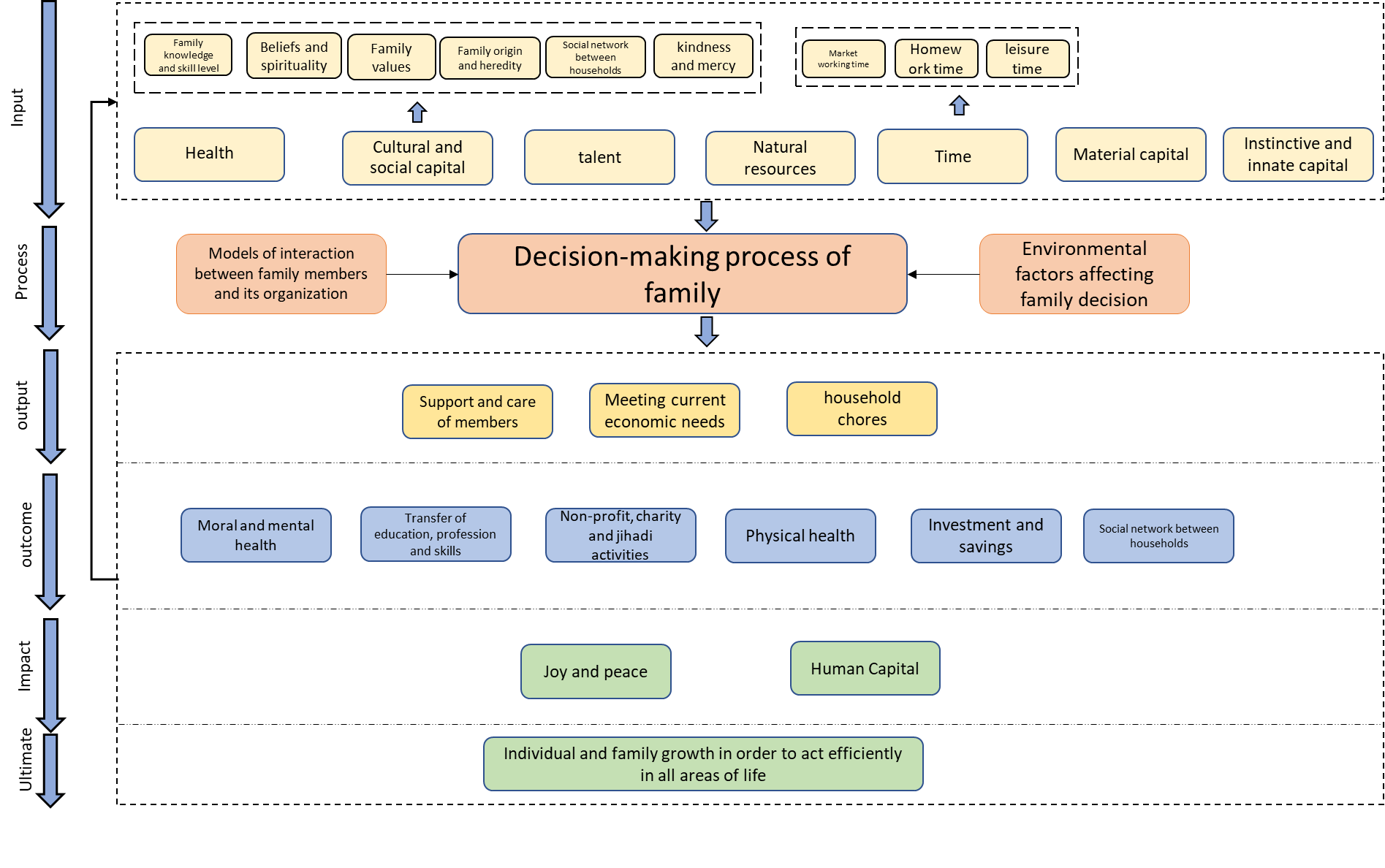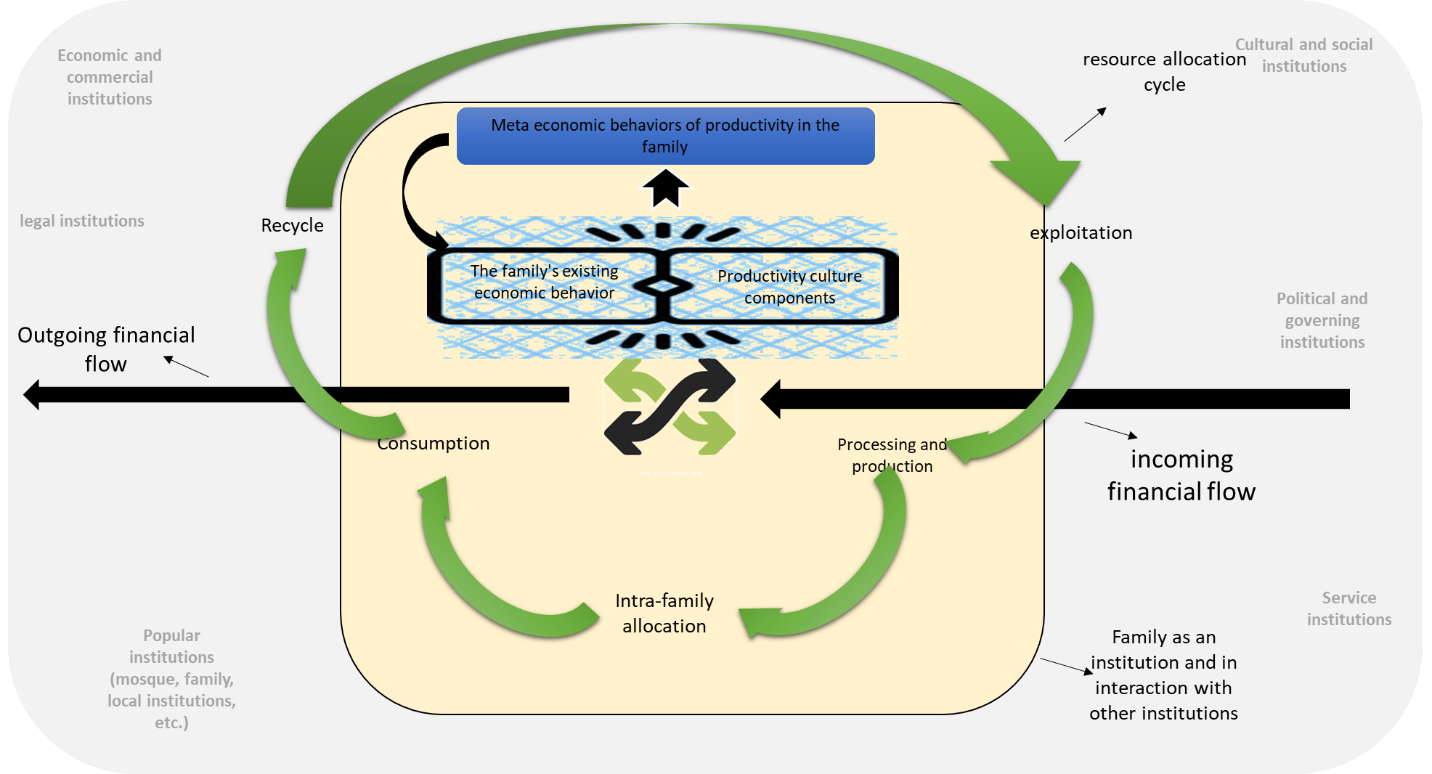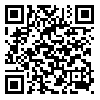Volume 23, Issue 91 (2-2024)
refahj 2024, 23(91): 323-364 |
Back to browse issues page
Download citation:
BibTeX | RIS | EndNote | Medlars | ProCite | Reference Manager | RefWorks
Send citation to:



BibTeX | RIS | EndNote | Medlars | ProCite | Reference Manager | RefWorks
Send citation to:
Mousavi Loghman S A, Moosavi S S, Davoudi Zadeh L, Pishvaee M S. (2024). Developing a conceptual model of "family productivity" with an emphasis on the economic aspect using thematic analysis method. refahj. 23(91), : 9
URL: http://refahj.uswr.ac.ir/article-1-4216-en.html
URL: http://refahj.uswr.ac.ir/article-1-4216-en.html
Keywords: Family productivity, economic productivity, family well-being, theme analysis, disposition
Full-Text [PDF 737 kb]
(471 Downloads)
| Abstract (HTML) (818 Views)
Full-Text: (507 Views)
Extended Abstract
Introduction
The family, as a social institution, plays a key role in institutionalizing, accepting, and promoting the culture of productivity. Since the roots of productivity lie in the literature of economics and management, it has failed to establish conceptual links with the institution of “family.” Therefore, there is a need to clarify the concept of “family productivity” within the realm of family. This research aims to extract a model by delineating the components, dimensions, and different layers of the conceptual productivity of the family.
Method
Thematic Analysis with a focus on the “economic productivity” domain has been conducted through library studies and interviews with experts in the field.
Findings
By classifying themes, organizing themes, and emerging themes, the researcher identified concepts that are more analytically valuable in response to the research question.
Based on the information presented in this network, the organizing themes of the research in the domain of family productivity generally include: family inputs, family outputs, the framework of family action and decision-making, environmental and internal factors influencing family decisions. According to this network of themes, the conceptual model of family productivity is generally depicted in Figure 1. A conceptual model in Figure 2 has been extracted for family financial productivity and the orientation toward desirable behaviors and economic efficiency. This figure shows that economic activities take place in financial inflows and outflows, resource allocation cycles, or at the intersection and conflict of these three important areas. On the other hand, these actions occur in an institutional environment consisting of the family, cultural and social institutions, economic and commercial institutions, legal and legislative institutions, political and governance institutions, service institutions, civil institutions, and the international environment. Furthermore, the culture of productivity carries a symbolic system and imposes it on economic behaviors. Thus, by combining and blending the three pillars of the family, the culture of productivity, and economic activities, desirable economic behaviors are achieved.
A conceptual model in Figure 2 has been extracted for family financial productivity and the orientation toward desirable behaviors and economic efficiency. This figure shows that economic activities take place in financial inflows and outflows, resource allocation cycles, or at the intersection and conflict of these three important areas. On the other hand, these actions occur in an institutional environment consisting of the family, cultural and social institutions, economic and commercial institutions, legal and legislative institutions, political and governance institutions, service institutions, civil institutions, and the international environment. Furthermore, the culture of productivity carries a symbolic system and imposes it on economic behaviors. Thus, by combining and blending the three pillars of the family, the culture of productivity, and economic activities, desirable economic behaviors are achieved.
Discussion
In general, as the family becomes more complete and matures in any domain, its ability to plan and rationalize increases, leading to greater productivity. The productive family is associated with concepts such as an efficient and successful family (worldly aspect), a happy family (spiritual aspect), a healthy family (physical and mental health), and so on. Past researchers from their perspectives have provided definitions of excellence and a good and complete family, each of which is related to some aspects of this research.
In addition, this system is collective, and the type of interaction and mutual actions flowing within it can have different levels of effectiveness and productivity, from a family that is struggling for its survival while also creating costs and losses for society to a family that is a source of well-being and blessings for itself and others.
The calendar has listed the characteristics of a productive home and family. Furthermore, five areas of home and family productivity have been identified, including scientific and educational growth, cultural and social spheres, economic sphere, home environment, and health (Calantari, 2021).
Regarding the well-being perspective, Sapari has examined the family and identified five areas of family well-being, including family relationships, economic status, health and safety, social relations, and spirituality. Another study has highlighted family communications, economy, health, family security, social participation, religion, household work, and the environment as effective factors in family well-being. These factors can also apply to a productive family and predict it.
The second main theme emphasizes the foundations of productive economic behaviors. According to the definition, it can be considered as a specific type of behavior that becomes ingrained in an individual over time and becomes a habit in some way. In actualizing behavior, in addition to belief, the two factors of need and capability also play a significant role. In other words, unless a need for a behavior is created and the individual’s capabilities are sufficient to perform that behavior, the behavior will not manifest in the individual. Therefore, behavior is contingent on belief, need, and capability, and all three must exist simultaneously for behavior to be realized (Pishvaee, 2015).
The cultural components of productivity in an institution such as the family are repeatable and can be practiced, and this culture can easily be transmitted through the family. The family, with its collective nature, embodies compassion, cooperation, generosity, and altruism.
Ethical considerations
Authors’ contributions
All authors were involved in the conceptualization, design, data collection, analysis, and interpretation of the findings.
Funding
Financial support for this research was provided by the National Productivity Organization.
Conflicts of interest
The authors declared no conflicts of interest that could have influenced the research findings or their interpretation.
Following the ethics of research
In accordance with the ethics of research, all references cited in this article were properly acknowledged and listed in the reference section. The resources used in this study were carefully selected and evaluated to ensure their relevance and reliability.
Introduction
The family, as a social institution, plays a key role in institutionalizing, accepting, and promoting the culture of productivity. Since the roots of productivity lie in the literature of economics and management, it has failed to establish conceptual links with the institution of “family.” Therefore, there is a need to clarify the concept of “family productivity” within the realm of family. This research aims to extract a model by delineating the components, dimensions, and different layers of the conceptual productivity of the family.
Method
Thematic Analysis with a focus on the “economic productivity” domain has been conducted through library studies and interviews with experts in the field.
Findings
By classifying themes, organizing themes, and emerging themes, the researcher identified concepts that are more analytically valuable in response to the research question.
Based on the information presented in this network, the organizing themes of the research in the domain of family productivity generally include: family inputs, family outputs, the framework of family action and decision-making, environmental and internal factors influencing family decisions. According to this network of themes, the conceptual model of family productivity is generally depicted in Figure 1.
Figure 1 Conceptual model of family productivity

Discussion
In general, as the family becomes more complete and matures in any domain, its ability to plan and rationalize increases, leading to greater productivity. The productive family is associated with concepts such as an efficient and successful family (worldly aspect), a happy family (spiritual aspect), a healthy family (physical and mental health), and so on. Past researchers from their perspectives have provided definitions of excellence and a good and complete family, each of which is related to some aspects of this research.
In addition, this system is collective, and the type of interaction and mutual actions flowing within it can have different levels of effectiveness and productivity, from a family that is struggling for its survival while also creating costs and losses for society to a family that is a source of well-being and blessings for itself and others.
The calendar has listed the characteristics of a productive home and family. Furthermore, five areas of home and family productivity have been identified, including scientific and educational growth, cultural and social spheres, economic sphere, home environment, and health (Calantari, 2021).
Regarding the well-being perspective, Sapari has examined the family and identified five areas of family well-being, including family relationships, economic status, health and safety, social relations, and spirituality. Another study has highlighted family communications, economy, health, family security, social participation, religion, household work, and the environment as effective factors in family well-being. These factors can also apply to a productive family and predict it.
The second main theme emphasizes the foundations of productive economic behaviors. According to the definition, it can be considered as a specific type of behavior that becomes ingrained in an individual over time and becomes a habit in some way. In actualizing behavior, in addition to belief, the two factors of need and capability also play a significant role. In other words, unless a need for a behavior is created and the individual’s capabilities are sufficient to perform that behavior, the behavior will not manifest in the individual. Therefore, behavior is contingent on belief, need, and capability, and all three must exist simultaneously for behavior to be realized (Pishvaee, 2015).
The cultural components of productivity in an institution such as the family are repeatable and can be practiced, and this culture can easily be transmitted through the family. The family, with its collective nature, embodies compassion, cooperation, generosity, and altruism.
Figure 3. Conceptual model of how the economic behaviors of productivity in the family appear in different fields of the economy


Ethical considerations
Authors’ contributions
All authors were involved in the conceptualization, design, data collection, analysis, and interpretation of the findings.
Funding
Financial support for this research was provided by the National Productivity Organization.
Conflicts of interest
The authors declared no conflicts of interest that could have influenced the research findings or their interpretation.
Following the ethics of research
In accordance with the ethics of research, all references cited in this article were properly acknowledged and listed in the reference section. The resources used in this study were carefully selected and evaluated to ensure their relevance and reliability.
Type of Study: orginal |
Received: 2023/06/7 | Accepted: 2023/10/21 | Published: 2024/02/14
Received: 2023/06/7 | Accepted: 2023/10/21 | Published: 2024/02/14
Send email to the article author
| Rights and permissions | |
 |
This work is licensed under a Creative Commons Attribution-NonCommercial 4.0 International License. |






